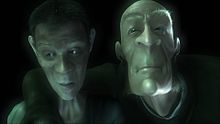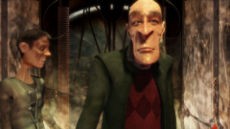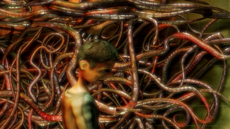- Elephants Dream
-
Elephants Dream 
A frame from the final rendering.Directed by Bassam Kurdali Produced by Ton Roosendaal Starring Cas Jansen
Tygo GernandtMusic by Jan Morgenstern Release date(s) 2006 Running time 10 min 54 sec Language English Budget €120,000 Elephants Dream is a computer-generated short film that was produced almost completely using the free software 3D suite Blender (except for the modular sound studio Reaktor and the cluster that rendered the final production, which ran Mac OS X). It premiered on March 24, 2006, after about 8 months of work. Beginning in September 2005, it was developed under the name Orange by a team of seven artists and animators from around the world. It was later renamed Machina and then to Elephants Dream after the way in which Dutch children's stories abruptly end.[1]
Contents
Overview
The film was first announced in May 2005 by Ton Roosendaal, the chairman of the Blender Foundation and the lead developer of the foundation's program, Blender. A 3D modelling, animating, and rendering application, Blender was the primary piece of software used in the creation of the film. The project was joint funded by the Blender Foundation and the Netherlands Media Art Institute. The Foundation raised much of their funds by selling pre-orders of the DVD. Everyone who preordered before September 1 has his or her name listed in the film's credits. The bulk of processing for rendering the film was donated by the BSU Xseed, a 2.1 TFLOPS Apple Xserve G5-based supercomputing cluster at Bowie State University. It reportedly took 125 days to render, consuming up to 2.8GB of memory for each frame.[2] The completed film is 10 minutes 54 seconds long, including 1 minute and 28 seconds of credits.
The film's purpose was primarily to field test, develop and showcase the capabilities of open source software, demonstrating what can be done with such tools in the field of organizing and producing quality content for films.
During the film's development, several new features such as an integrated node-based compositor, hair and fur rendering,[3] rewritten animation system and render pipeline, and many workflow tweaks and upgrades were added into Blender especially for the project.
The film's content was released under the Creative Commons Attribution license, so that viewers may learn from it and use it however they please (provided attribution is given).[4] The DVD set includes NTSC and PAL versions of the film on separate discs, a high-definition video version as a computer file, and all the production files.
The film was released for download directly and via BitTorrent on the Official Orange Project website on May 18, 2006, along with all production files.
Plot and explanation
The movie was made mostly as an experiment, rather than to tell a certain story and therefore has a strong arbitrary and surreal atmosphere. It features two men, Proog (the elder and more experienced) and Emo (the younger and more nervous) living in a miraculous construction referred to only as "The Machine"; Proog tries to introduce Emo to its nature but the latter is reluctant and argues about its purpose. The creators originally intended for the movie to show the abstraction of a computer.
The final message is not easy to see due to the abstract nature of the movie and therefore some viewers criticized it as pointless and random, and worthy of attention only if seen as a demo. Other people have widely different interpretations of its meaning. Proog cannot abide imaginative, unpredictable fun in his so carefully crafted and isolated logical world, which is why he tries to dominate Emo and eventually attacks him. Another theory is connected to the theory of evolution, with Proog and the Machine representing multicellular life and DNA, whereas Emo represents a single mitochondrion and cannot grasp the complexity of the Machine.
Bassam Kurdali, Director of Elephants Dream, explained the plot of the movie by saying:[5]
"The story is very simple—I'm not sure you can call it a complete story even—It is about how people create ideas/stories/fictions/social realities and communicate them or impose them on others. Thus Proog has created (in his head) the concept of a special place/machine, that he tries to "show" to Emo. When Emo doesn't accept his story, Proog becomes desperate and hits him. It's a parable of human relationships really—You can substitute many ideas (money, religion, social institutions, property) instead of Proog's machine—the story doesn't say that creating ideas is bad, just hints that it is better to share ideas than force them on others. There are lots of little clues/hints about this in the movie—many little things have a meaning—but we're not very "tight" with it, because we are hoping people will have their own ideas about the story, and make a new version of the movie. In this way (and others) we tie the story of the movie with the "open movie" idea."
The original title was to be Machina but was dropped due to pronunciation issues.
Descriptive storyline
The movie opens on a small bridge between two nearly endless walls. An old man, Proog, shoves the younger and less experienced Emo on the ground to save him from being mowed down by a barrage of jack plugs that whir back and forth between the two massive, 1930-40s switch-board-like walls. The plugs are oblivious of the two, endlessly channeling streams of bizarre sounds and data. After the squealing plugs move on, Proog makes sure that Emo is unharmed and urges him onwards through a crack in one of the plug-walls, saying that "it isn't safe" and that they should go.
They walk through the narrow hall into a massive room that fades away into blackness on all sides. Only one path is visible, suspended in mid-air that runs between thousands of dangling electric cables on which sit crowds of robin-like robotic birds. As Proog and Emo enter the room, the birds begin to wake up and notice them. Realizing the danger, Proog grabs Emo by the arm and yells to hurry.
They run along the increasingly bizarre path as the birds begin to swarm. All sound is blocked out by the birds which are making the same noises as the jack-plugs, garbled screaming and obscure sentences and static. The path dead-ends, stopping in the middle of no-where above the infinite drop. Proog turns around as the birds reach them and begin to dive-bomb at them. At the last moment, Proog takes out an old candlestick phone and the bird dives into the speaker piece. The screen cuts to black.
In the next scene, Proog stands at one end of a room, suspiciously watching what is probably the same candlestick phone, which is ringing. Emo watches from the other side of the room. The phone continues to ring. After a while Emo approaches it to answer it, but Proog slaps his hands away, Emo asks why he can't answer it, and Proog picks up the phone gingerly and takes the ear-piece off the hook. As soon as the ear-piece is activated, the speaker grille slides open revealing, tangled in with the wires of the phone, a seething mass of clawed, fleshy polyps which scream and gibber obscenely in the same mechanical, staticky voice that everything else in the Machine speaks in. Proog warns that Emo could die if he's not more careful next time. There is a solemn silence, then Emo laughs in disbelief. The screen cuts to black.
After another interlude, the two enter another massive black room. There is no path, the entry platform is the only structure that seems to be there except for another exit, lit distantly at the far side. Proog takes a step forward into the void, and his feet are suddenly caught by giant typewriter arms that rocket up out of the blackness to catch his feet as he dances across mid-air. Emo follows Proog with somewhat less enthusiasm as the older man leads the way and all the while lectures Emo about the dangers of the Machine, stating it could grind them into pulp. When Emo tries to reason around the probability of dying, Proog interrupts him by shouting "pulp!" with greater and greater fervor until Emo gives up and lapses into silence.
They reach the end of the room and go through a door into a small compartment. Proog presses a button, and the door closes. It is an elevator. The elevator lurches suddenly as it is grabbed by a giant mechanical arm and thrown upwards, rushing up through an ever-widening tunnel. When it begins to slow down, another arm grabs the capsule and throws it even further up.
As it moves up, the walls unlock and fall away, leaving only the floor with the two on it, rushing higher and higher. Proog tells Emo to close his eyes just before the platform exits the tunnel and sails into a black sky. As it reaches the peak of its arc, Proog asks Emo what he sees to the left and the right, and Emo says he sees nothing. The elevator begins to drop down another shaft, finally coming to rest as it slams into the floor of another room, fitting into a hole in the ground and bringing the two to a level stop. A camera flashes.
They are in a large, dingy room filled with strange, organic looking generator-like devices and dotted with boxy holographic projectors. One of them is projecting a portion of wall with a door in it right beside them. From behind the door comes light music. The door seems harmless enough, but when Emo asks if they can go in there, Proog says, once again, that it isn't safe. He refuses to answer any more questions, and instead presses a button on his cane, which changes the holograph to another wall.
After an interlude, the scene begins with Proog finishing the wall, and boxing them into a Safe Room, out of the view of anything outside. He then turns and confronts Emo, asking why Emo can't see the beauty and perfection of the Machine, in spite of the danger. Emo replies that it is because it isn't there, and he doesn't see any of the things they've been going through, so why should he trust his life to something that isn't there? Proog starts in frustration, but Emo interrupts and demands an answer. Proog slaps him, trying to bring him to his senses, but Emo calls him a sick man, while storming away down the length of the room towards a wall he apparently cannot see. Proog watches in horror as—instead of Emo walking into the wall—the wall begins to move, extending the length of the room to accommodate Emo's belief that none of it is real. Proog yells after him that it's a trap, and Emo turns around and begins to taunt him.
Emo: "It's a trap. [scoffs] At the left side you can see... The Hanging Gardens of Babylon!... How's that for a trap?"
As he speaks, the walls begin to discolour and mechanical roots start tearing through the walls to his left, moving forwards towards Proog. In spite of the old man's pleas to stop, Emo continues.
"Oh, and at the right side you can see... Well, guess what! The Colossus... of Rhodes! [laughing] The Colossus of Rhodes! And it is here just for you, Proog! Just for you!"
The rest of the safety wall crumples away as a pair of massive hands heave out of the ground and begin to attack. Proog is knocked down by the shockwave, while Emo turns and begins to walk away, waving his finger around his temple in the 'crazy' sign, completely unaware of everything that's happening. In a last effort, Proog extricates himself from the tentacle roots, and cracks Emo over the back of the head with his cane. As Emo's eyes roll back and he collapses, everything falls away, and Proog and Emo are left in one tiny patch of light in the middle of blackness.
As the screen fades to whole black, Proog whispers to the prone figure of Emo that "it is there."
The final shot pans downwards from Emo's bloodless, pale hand. The 'dead' tentacles lay, inoperable and useless. The credits roll.
Stereoscopic 3D version
In 2010 Elephants Dream was entirely re-rendered in stereoscopic 3D by Wolfgang Draxinger. The project was announced to the public in mid September on BlenderNation[6] and premiered on the 2010 Blender Conference[7].
Noteworthy Facts
Unlike the original version, which was in Full-HD resolution (1920×1080), the stereoscopic version was rendered in Digital Cinema 2k flat resolution (1998×1080), a slightly wider aspect format, which required adjustment of the camera lens parameter in every shot.
A lot of scenes in the original production files used flat 2D matte paintings, which got integrated into the rendered images during the compositing phase. For the 3D production each matte painting had to be manipulated or entirely recreated into versions for each eye.
Wolfgang Draxinger implemented a number of stereoscopic features in Blender to aid in the stereoscopic production process. These may find way into the upcoming Blender-2.5 versions.
Award
Elephants Dream 3D did compete in the first European 3D Film Festival and was awarded best short film.[8].
Short film video
Full length video of Elephants Dream - ~10 minutesCast
- Tygo Gernandt - Proog
- Cas Jansen - Emo
Crew
- Ton Roosendaal - Producer
- Bassam Kurdali - Director
- Andy Goralczyk - Art director
- Matt Ebb - Artist
- Bastian Salmela - Artist
- Lee Salvemini - Artist
- Toni Alatalo - Technical director
- Jan Morgenstern - Composer
Software and tools used
Blender was the main program used to create the 3D animation of the film. The other programs were used for pre and post-production, file management, collaboration, and scripting. Ubuntu with KDE and GNOME desktop environments was used on the workstations.
Notes
- ^ Tom Roosendaal (producer); Lee Cocks (lead artist); Matt Ebb (lead artist); Bassam Kurdali (animation director); Andy Goralczyk; (technical director) (ogv). [[1], link to precise clip: [2] Making of Elephants Dream] (Motion picture). Netherlands: Blender Foundation / Netherlands Media Art Institute / www.elephantsdream.org. Event occurs at 11 minutes 50 seconds until 13 minutes 10 seconds. [3], link to precise clip: [4].
- ^ "CGSociety - Elephants Dream". Features.cgsociety.org. 2006-05-19. http://features.cgsociety.org/story_custom.php?story_id=3583. Retrieved 2009-05-05.
- ^ "Elephants Dream » Archive » Hairy Issues // updated!". Orange.blender.org. http://orange.blender.org/blog/hairy-issues. Retrieved 2009-05-05.
- ^ "Elephants Dream » Archive » Creative Commons license". Orange.blender.org. http://orange.blender.org/blog/creative-commons-license-2. Retrieved 2009-05-05.
- ^ "marhaban ya shabab (wa shabbat ) min bassam - المنابر". Maxforums.net. http://maxforums.net/showthread.php?t=93390. Retrieved 2009-05-05.
- ^ "Rendering Elephants Dream in Stereoscopic 3D". blendernation.com. 2010-09-17. http://www.blendernation.com/2010/09/17/rendering-elephants-dream-in-stereoscopic-3d/. Retrieved 2010-12-16.
- ^ "Blender Conference 2010 schedule". blender.org. 2010-10-28. http://www.blender.org/community/blender-conference/schedule/. Retrieved 2010-12-16.
- ^ "The First European 3D Film Festival - Awards". 3dmedia2010.com. 2010-12-10. http://3dmedia2010.com/en/3d-film-festival-0. Retrieved 2010-12-16.
External links
- Official homepage
- Elephants Dream at the Internet Movie Database
- Elephants Dream is available for free download at the Internet Archive [more]
- Elephants Dream on YouTube
- Elephants Dream 3D on YouTube
- Elephants Dream 3D on Vimeo
Blender Foundation Blender • Suzanne Award • Ton RoosendaalFilms Elephants Dream (2006) • Big Buck Bunny (2008) • Sintel (2010)Video games Yo Frankie! (2008)Categories:- English-language films
- 2006 films
- Computer-animated films
- Dutch films
- Open content short films
- Creative Commons-licensed films
Wikimedia Foundation. 2010.


